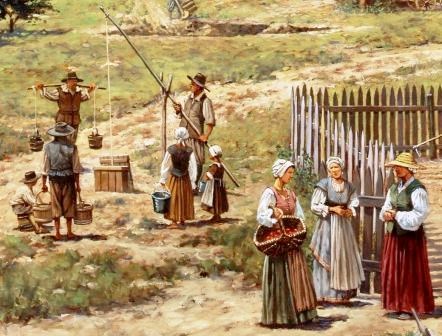
National Park Service, Colonial NHP
Sir Edwin Sandy, Treasurer
THE LURE OF VIRGINIA - GOD, GLORY, AND GOLD: These were the forces that lured the first English settlers in 1606 to the new and untamed wilderness of Virginia. They carried with them the Church of England and the hopes to convert the Native Americans to Protestant Christianity. They wanted to establish an English hold on the New World and exploit its resources for use in the mother country. Some desired to find its fabled gold and riches and others longed to discover a northwest passage to the treasures of the Orient. INITIAL LACK OF WOMEN: The settlers were directed by the Virginia Company of London, a joint-stock commercial organization. The company's charter provided the rights of trade, exploration and settlement in Virginia. The first settlers that established Jamestown in 1607 were all male. Although some, like historian, Alf J. Mapp Jr. believe that "...it was thought that women had no place in the grim and often grisly business of subduing a continent..." the omission of women in the first group of settlers may simply mean that they were not, as yet, necessary. REASONS BEHIND DELAY: The company's first priority in Virginia was possibly to build an outpost, explore and determine the best use of Virginia's resources for commercial profits. The exclusion of women in the first venture supports the possibility that it was an exploratory expedition rather than a colonizing effort. According to historian Philip A. Bruce, it is possible that had colonization not been required to achieve their commercial goals, the company might have delayed sending permanent settlers for a number of years. ESTABLISHING PERMANENCY: Once the commercial resources were discovered, the company's revenues would continue only if the outpost became permanent. For Jamestown to survive, many unstable conditions had to be overcome.
WOMEN'S INDISPENSABLE ROLE: Providing the stability needed for Jamestown's survival was the indispensable role played by Virginia women. Their initial arrival in 1608 and throughout the next few years contributed greatly to Jamestown's ultimate success. Lord Bacon, a member of His Majesty's Council for Virginia, stated about 1620 that "When a plantation grows to strength, then it is time to plant with women as well as with men; that the plantation may spread into generations, and not be ever pieced from without." CONTRIBUTIONS OF EARLY VIRGINIA WOMEN: The first woman to foster stability in Jamestown was not an English woman but a native Virginian. Pocahontas, the daughter of Chief Powhatan, was among the first Native Americans to bring food to the early settlers. She was eventually educated and baptized in the English Religion and in 1614 married settler John Rolfe. This early Virginia woman helped create the "Peace of Pocahontas," which for several years, appeased the clash between the two cultures. One of the first English women to arrive and help provide a home life in the rugged Virginia wilderness was young Anne Burras. Anne was the personal maid of Mistress Forrest who came to Jamestown in 1608 to join her husband. Although the fate of Mistress Forrest remains uncertain, that of Anne Burras is well known. Her marriage to carpenter John Laydon three months after her arrival became the first Jamestown wedding. While Jamestown fought the become a permanent settlement, Anne and John began a struggle to raise a family of four daughters in the new Virginia wilderness. Certainly, Anne and her family began the stabilization process which would eventually spur the colony's growth. Another young woman, Temperance Flowerdew, arrived with 400 ill-fated settlers in the fall of 1609. The following winter, dubbed the "Starving Time," saw over 80 percent of Jamestown succumb to sickness, disease and starvation. Temperance survived this season of hardship but soon returned to England. By 1619, Temperance returned to Jamestown with her new husband, Governor George Yeardley. After his death in 1627, she married Governor Francis West and remained in Virginia until her death in 1628. Her many years in Virginia as a wife and mother helped fill the gap in Jamestown's early family life. In July 1619, settlers were granted acres of land dependent on the time and situation of their arrival. This was the beginning of private property for Virginia men. These men, however, asked that land also be allotted for their wives who were just as deserving "...because that in a newe plantation it is not knowen whether man or woman be the most necessary." The Virginia Company of London seemed to agree that women were indeed quite necessary. They hoped to anchor their discontented bachelors to the soil of Virginia by using women as a stabilizing factor. They ordered in 1619 that "...a fit hundredth might be sent of women, maids young and uncorrupt, to make wives to the inhabitants and by that means to make the men there more settled and less movable...." Ninety arrived in 1620 and the company records reported in May of 1622 that, "57 young maids have been sent to make wives for the planters, divers of which were well married before the coming away of the ships." Jamestown would not have survived as a permanent settlement without the daring women who were willing to leave behind their English homes and face the challenges of a strange new land. These women created a sense of stability in the untamed wilderness of Virginia. They helped the settlers see Virginia not just as a temporary place for profit or adventure, but as a country in which to forge a new home. BIBLIOGRAPHY:
|
Last updated: February 26, 2015
